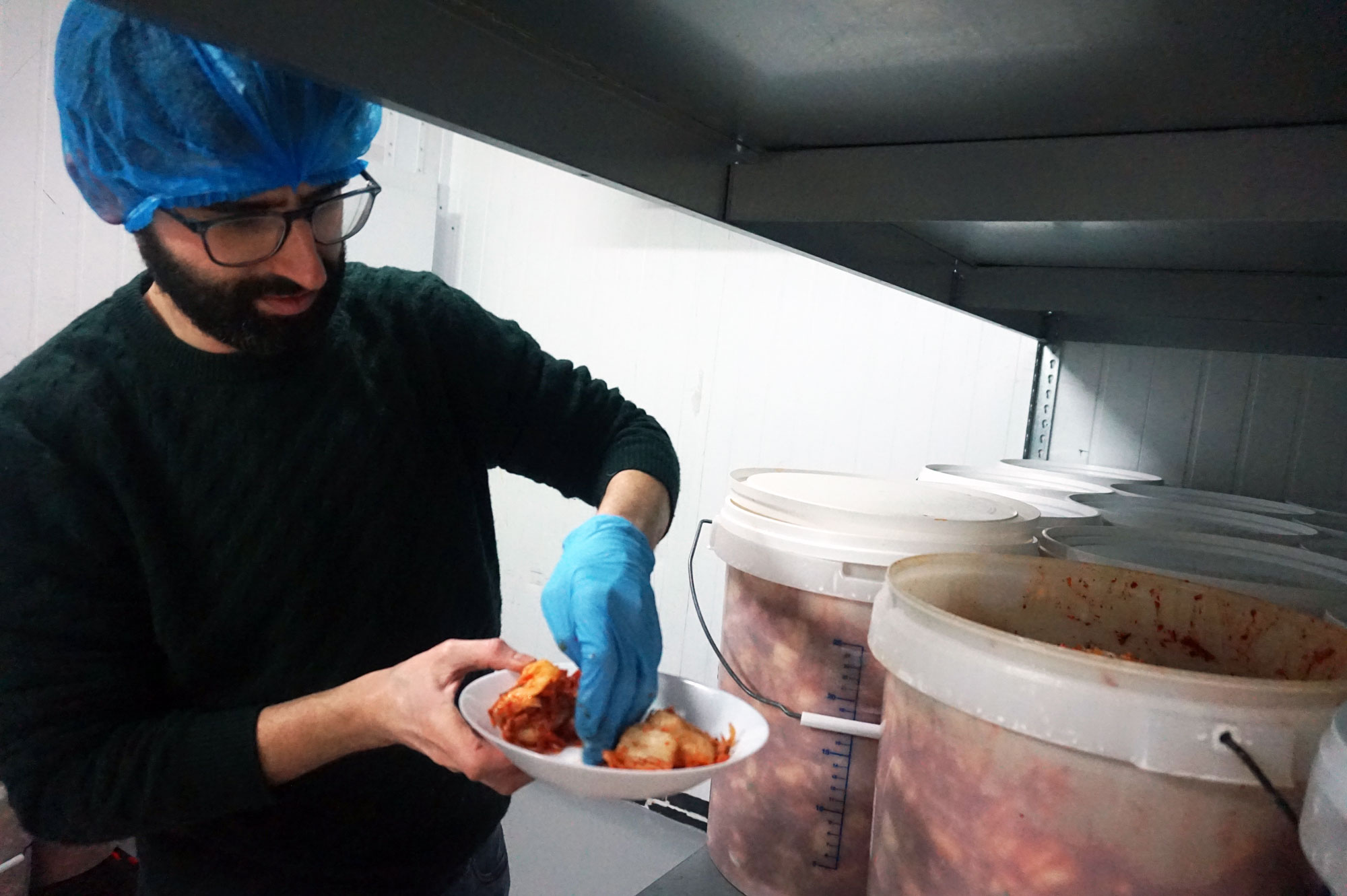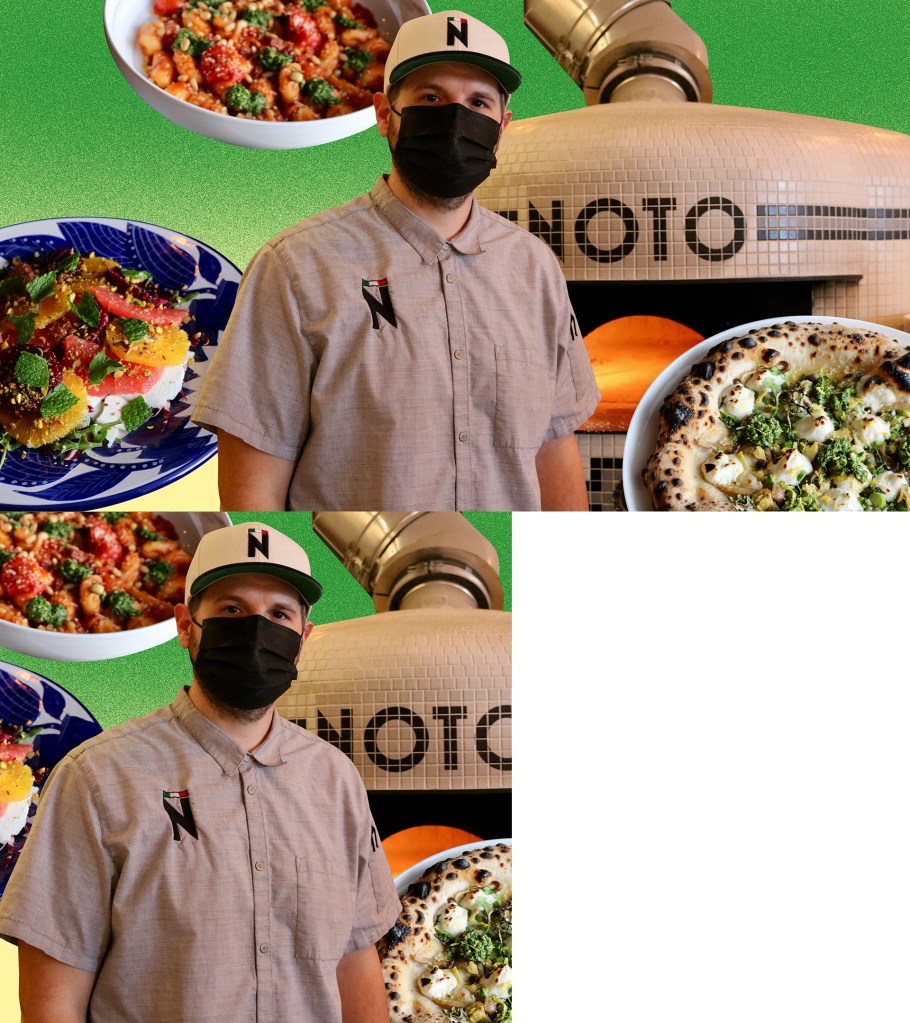It’s a freakishly warm day for February in South London. Aside from the concern that we’re all going to die in a climate apocalypse, my most pressing worry is that it’s way too hot to be stuck in a kitchen, let alone stuck in a kitchen trying to make fermented food.
And yet, in the railway arch where raw fermented food specialists Eaten Alive recently set up shop, everything is cool, calm, and collected. I’m guided past temperature-controlled refrigerators, tubs of chronologically labeled kimchi, and endless pristine countertops. It’s like an obsessively ordered science lab, only with less test tubes and more funky vegetables.
Videos by VICE
“Today’s weather is actually not too bad, it can be worse in the summer when our vegetables ferment too quickly, or too slowly in the winter,” Eaten Alive co-founder Glyn Gordon tells me.


Pat Bingley, fellow founder, chimes in: “That’s the thing when you work with a live product, it’s hard to be consistent without too many variations. Despite going to such lengths to keep stable and optimum fermentation, there’s always going to be a certain element that’ll be out of your hands.”
Fermented dishes crop up across the ages and cuisines—from Korean kimchi to French cornichons, Russian beet kvas, and kombucha. The process usually involves soaking the fruit or vegetables in salted water, allowing for the growth of bacteria that eats at its natural sugars to produce an appealingly tart taste. The resulting lactic acid bacteria found in fermented foods is also purported to have numerous health benefits, including improved digestion and immune function.
Gordon and Bingley use this lacto-fermentation process to create their kimchi and saurkraut. The ingredients are salted and left at room temperature for up to three weeks, before being moved into cold storage. This completes the fermentation process and adds extra depth to the finished products’ flavour.

“Everything we make is vegan,” Bingley says. “Actually, that’s how we came about, we were asked to develop a vegan kimchi recipe for a friend to use in their restaurant. Eventually we grew via word-of-mouth, started to become more involved in it, and Eaten Alive slowly became our full-time thing.”
The pair have been supplying kimchi and sauerkraut to specialist shops and London restaurants, including Soho House, Nanban, and Chick ’n’ Sours, since 2016. Eaten Alive also makes a fermented Scotch bonnet hot sauce, and is developing new varieties including preserved lemon, smoky sriracha, and chocolate barbecue. So, while temperature and climate may not always be ideal, Gordon and Bingley have clearly learned how to work with the elements to make fermented magic happen.
Which is unsurprising when you consider that their original plan was to open a fermentation restaurant. These two are serious pickle enthusiasts.
“We still want to open a pickle restaurant!” Bingley confesses. “We’ll go back to it eventually, but it probably wouldn’t be a smart move to just abandon something that we love and worked so hard on for the last two years.”

The pair met in the kitchen at Disco Bistro, a pop-up that took over a pub in Central London in 2013. Prior to that, Gordon worked as a pastry chef under Simon Rogan at Fera at Claridge’s and L’Enclume, while Bingley cooked at The Ledbury. Founding Eaten Alive was something of a learning curve after years of working in restaurants.
“We’re not businessmen. We knew how to chop cabbage and create recipes, but not crunch numbers,” Bingley says. “As our company’s gotten bigger, we’ve had to cut back on some of the fun experimental things we began doing in the earlier days. Currently, we’re focused on selling our bread and butter, like kimchi and hot sauces.”
Eaten Alive’s signature product, its classic kimchi, is made with Chinese leaf, carrot, spring onion, and apple; plus plenty of garlic, ginger, and Korean chili flakes. The “Golden” version comes with added fresh turmeric.
On the day of my visit, the Eaten Alive team has already worked its way through a week’s worth of produce: 1,000 kilograms of cabbage and 500 kilograms of other vegetables, chopped and ready to be processed. They’ll spend the rest of the week disinfecting jars, salting, mixing, and hoping for the best.

“We’ve just made our 100th batch of kimchi,” Gordon says proudly. “We can’t quite believe we’ve made it this far after thinking this was going to be a side project for a couple of months.”
“There’s no vinegar in anything we do, it’s all a natural process and this method of preserving has been around for thousands of years. Essentially, it’s leaving everything to its own devices and checking in every so often,” he adds.
In such a busy production environment, family meals are an important part of the Eaten Alive team’s working day. I follow Gordon and Bingley into the factory kitchen, where Gordon sets a frying pan on the stove.
“Today, we’re going to make jerk chicken tacos,” he says.
Staff meals also function as a way to test Eaten Alive’s kimchi, sauerkraut, and hot sauces with a variety of dishes.
“Honestly, you can try them with a lot of things such as sandwiches, salads, stir-fries, and generally any cheese-pairing is great,” Gordon says.


We take our tacos upstairs to the Eaten Alive office, where you can hear the trains rumbling overhead. The table is dotted with dishes of multi-coloured pickles, wrinkled plums, bright jars of kimchi, and sliced preserved vegetables.
“These are Gordon’s babies,” Bingley laughs, gesturing to the impressive fermented spread.
“They’re our experiments where we play around with different ingredients, flavour profiles, and textures. They’re not really for sale, just for personal use,” Gordon explains. “My favourite out of all them is the fermented preserved lemon, where I bully my retired Israeli mother who lives in Herzliya into growing lemons for me, then help me deseed and shred to make this.”
He points to a dish of intriguing yellow lemon slices. I scoop a generous portion onto my taco and take a bite. As soon as it hits my tongue, I can feel myself make an ugly sour face. It’s delicious, but it sure does have a zesty kick to it.
“Yeah,” Gordon laughs when he sees my face. “It’s an acquired taste, that one.”




